Archived Fire Damage Blog Posts
Factors To Consider When Buying a Smoke Detector
6/22/2022 (Permalink)
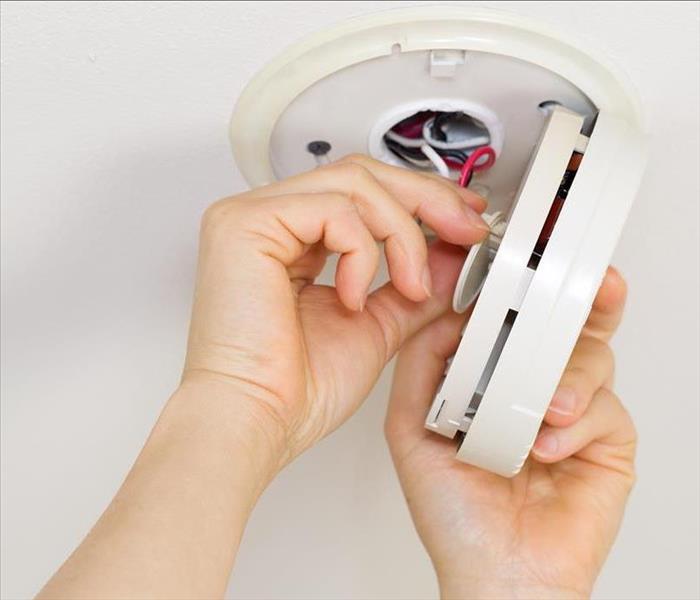 Know more about your Smoke Detectors and avoid Fire Damage in your property.
Know more about your Smoke Detectors and avoid Fire Damage in your property.
While you may hope that flames never touch your place in Clearfield, UT, the reality is that blazes happen. The Nation Fire Protection Agency reports that between 2015 to 2019, approximately one-quarter of fires occurred within homes. Furthermore, fire crews attended to at least 346,800 residential fire-related calls.
During these dire times, a smoke alarm serves as the first line of defense, signaling trouble and helping people escape.
Tips for Picking the Right Smoke Alarm for Your Home
Like any device, alarms break or deteriorate with age. They should last about 7 to 10 years. However, life happens, and you may need to upgrade sooner. It's essential to check them every six months, replacing batteries at that time and ensuring they work correctly. The following are signs of a broken or malfunctioning unit:
- Constantly chirps or beeps
- Color lights don't match the book guides
- Reacts suddenly without cause
- Fails to go off during testing
If you have a smoke detector with one of the following conditions, it's time to grab a new one. Use the following information to invest in the right option to safeguard your home.
1. Understand the Initial Layout and Connections
Know how the builders installed detectors. They may have put in hard-wired or battery-powered units. Keep the same format, although can swap out for different manufacturers. Hard-wired selections are connected throughout the home. When one is triggered, they all go off, creating additional noise and, perhaps, more warning. These devices often require an electrician's help.
Battery-operated devices are not connected and work as individual parts; people often find them more manageable to change on their own.
2. Pick Your Sensor
Discuss how you want smoke detected within the home. This interest influences your smoke alarm investment. Choose between photoelectric and ionization models. Do you want something that identifies flames? Photoelectric products recognize light; thus, they trigger with sparks. Ionization detectors act differently. They react with smoke. There are dual-sensor selections that pick up both.
3. Determine Your Need for Noise
Think about your home's size and the occupant's age and hearing. Those with smaller buildings and middle-aged, average-hearing adults may rely on traditional beeping units. These go off within the immediate vicinity, helping with fire safety measures. For instance, if a fire starts in the kitchen, the noise reacts nearby. Others hear it and can escape.
However, if you live in a larger home with multiple levels and rooms, you may not immediately recognize the noise. In addition, those with weaker hearing or younger kids may struggle too. Interconnected units increase the volume, allowing people to receive notifications throughout the home.
In addition, little ones may respond to voice alarms that indicate where the flames are located, helping avoid the area and find a suitable place for escape.
4. Get Profesional Input
Ask fire restoration experts to assess your home in Clearfield, UT, determining if you have enough smoke detectors. In addition, these specialists can advise you on whether you need additional units or should move alarms or upgrade them to meet safety codes.
When you're ready to purchase a smoke alarm, reflect on your home's original design and your current lifestyle. Select options that improve your escape plans and help loved ones find safety.
5 Factors To Consider When Installing Fire Alarms In Your Home
3/14/2022 (Permalink)
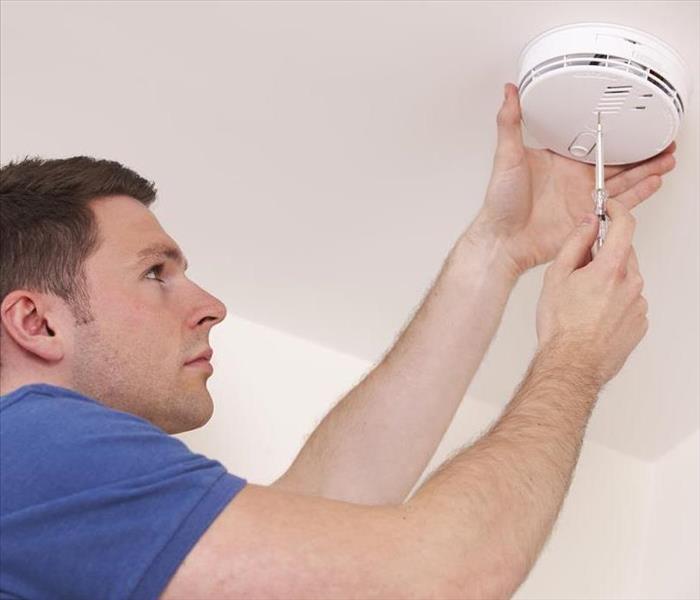 Installing Fire Alarms In Your Home can be Easier if you Follow These 5 Tips.
Installing Fire Alarms In Your Home can be Easier if you Follow These 5 Tips.
When you move into a new home in Clearfield, UT, there is so much to think about. How will each room be set up? What paint colors will you choose? One thing many new home owners forget to do is install a fire alarm. While you might not be thinking about your safety plan in the first few weeks of homeownership, it's an important step to take to keep your family safe.
Here are five factors to consider when installing fire alarms in your home.
5 Key Factors to Consider as regards Fire Alarms
1. Why Should I Install Fire Alarms?
Some people think that they don't need alarms in their homes. Maybe because the home is small, they think they'll notice any emergency. Some think that because they are light sleepers, they would smell smoke and have time to evacuate. Home fires can occur when you're not home, and even the most safety conscious person can have an accident.
Fire alarms save lives and prevent smoke damage to your belongings. If a fire does occur, an emergency restoration service can help repair your home.
2. How Many Floors Does My Home Have?
At an absolute minimum, you need to have one smoke detector on each floor of your home. If you have a basement, a main floor, and an upstairs, you need at least three alarms. The more square feet you have, the more alarms you need. In a small home, like an apartment, it may be sufficient to have one alarm near the bedrooms and one in the kitchen.
In a larger home, you want to be sure that an alarm can be heard not matter where a person is, so it would be important to put multiple alarms on each floor to keep everyone safe.
3. Where Should I Install a Fire Alarm?
The National Fire Protection Association recommends a fire alarm in each sleeping room and one outside the room. If you have two bedrooms upstairs, two on the main floor, and one in the basement, you should have at least eight alarms in your home.
4. What Type of Alarm Should I Install?
There are many brands of fire alarms to choose from. An alarm should detect smoke and carbon monoxide, but many can alert you to other problems too, like increased temperature. Alarms can be battery-operated or wired into the home.
Ideally, all alarms should be connected to one another so that when one sounds, all alarms sound. That ensures that everyone will know that there is an emergency.
5. How Often Do I Need to Check My Alarms?
Test your smoke alarms once a month. You're more likely to notice a low battery indicator or a problem in wiring when you check them often. Change the batteries when you change your clocks. When you move into a new home, replace the smoke detectors unless the seller told you when they did it. Otherwise, replace the alarms every ten years.
Moving to a new home is exciting and stressful. Take one stress off your plate and install smoke detectors all around your home to prevent fire damage and to keep your family safe.
When Should I Replace Smoke Alarm Batteries?
2/23/2022 (Permalink)
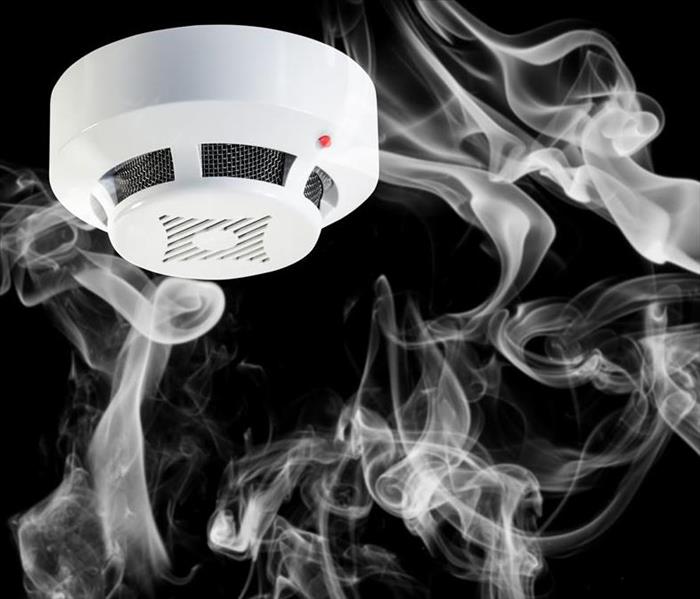 Learn More about Smoke Alarms and Prevent Fire Damage in your Clearfield, UT Home.
Learn More about Smoke Alarms and Prevent Fire Damage in your Clearfield, UT Home.
Many home fires become worse than necessary because their smoke alarm system malfunctioned. This happens because homeowners fail to replace the batteries in all the units or forget to perform regular maintenance on them. A smoke detector doesn't require much, but care is vital.
You should replace the batteries in each unit at least twice a year and then test them for functionality. Doing this can provide you with added peace of mind that your family and Clearfield, UT, home are protected against the worst.
Smoke Detector Maintenance Tips
In addition to replacing the batteries, there are several tips that fire damage restoration experts offer. Heeding these suggestions could mean the difference between minor to no damage and a total loss.
1. Ensure the Correct Placement of Each Unit
Smoke detectors must be installed in the correct locations to function correctly. One alarm must be installed in each bedroom. Additionally, at least one must be in the hallway (depending on the length of the space). Each of your home's floors (including the basement) must have at least one smoke alarm installed, ideally in every room.
The kitchen can be a little more complicated since there is a greater chance of false alarms when cooking. Units that are too close to the kitchen can also build grease residue, keeping them from functioning correctly.
2. Test Each Unit Regularly
Just as it's essential to replace the batteries often, it is also crucial to test each unit. Test the detectors every time you replace the batteries.
3. Clean Each Unit
Often Many people don't realize that you must clean a smoke alarm regularly. These units can gather dust, debris, and cobwebs like any other surface in your home. Cleaning is as simple as lightly wiping it down with a damp cloth or vacuuming it gently using your vacuum's hose.
4. Ensure You Have the Best System for Your Home
Several types of fire alarm systems are available, and they're becoming increasingly advanced to provide better protection. Interconnected units are either hardwired in your home or wireless and powered only by batteries. An interconnected system can prove to be very beneficial. The units communicate via radiofrequency. Therefore, if one is set off, they will all signal trouble. This means you will know there's a fire no matter where you are in the home. Some detectors even talk to tell you the fire area so that you can get to it quicker.
5. Replace Each Unit Routinely
Most fire alarms are manufactured to work for about 10 years. If you are unsure when your current ones were purchased, you can look for a date on the unit. Some devices have a sticker on the outside, and some have it on the label on the inside. If it is more than 10 years old or the date is unknown, it's best to replace it. After all, if it stops working correctly, it's as helpful as not having on at all.
Having a properly functioning smoke alarm system installed in your home is essential for avoiding potentially severe fire damage. Ensure your family's safety by following these five tips for maintaining your fire alarm system.
How To Restore Your Business After a Fire
1/11/2022 (Permalink)
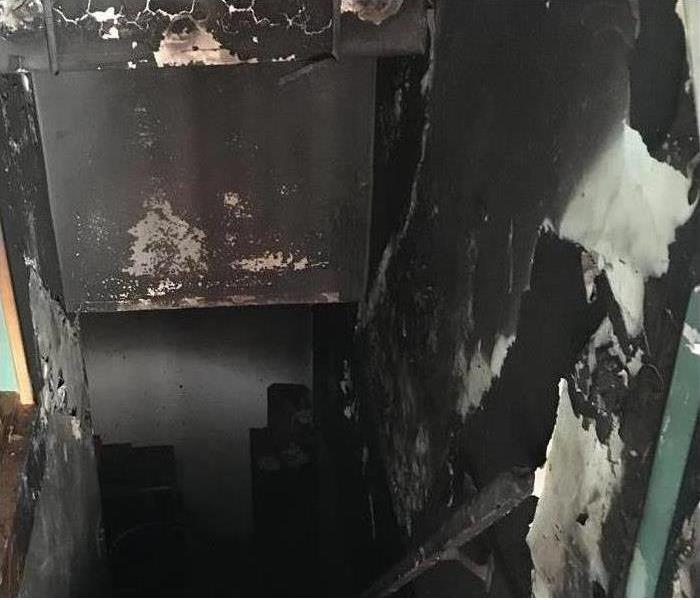 Fire Damage in Clearfield, UT.
Fire Damage in Clearfield, UT.
Coping with the aftermath of a fire on your commercial property may feel overwhelming at first. Not only do you have to deal with the destruction caused by the fire itself, but there might also be smoke damage, water damage, and troublesome soot left behind. Fortunately, things are not always as bad as they seem, and restoration is often possible. Here are a few steps to getting your business up and running again after a fire.
3 Steps to Restore Your Business After a Fire.
1. Evaluate the Damage
The first step is to develop a plan of action for the repairs. Calling a commercial fire restoration expert is the best way to ensure that any fire damage, smoke damage, or water damage is properly attended to. Trained professionals know what to look for and how to handle many common issues that occur after a fire. In addition to crafting a cleanup plan, they will take measures to prevent future damage. This includes boarding up destroyed windows and doors, as well as covering up holes in the siding or roof.
2. Water Removal
Oftentimes fire hoses leave excess water in the building. Water removal should be done promptly in order to prevent mold growth or more severe structural degradation. Restoration specialists begin by eliminating any standing water. Next, they use a combination of fans, dehumidifiers, and air movers to fully dry out the space.
3. Clearing Smoke and Soot
Dealing with soot damage and lingering smoke is one of the most important parts of fire cleanup. Soot and smoke may penetrate into linens, carpets, furniture, and other products. They can even damage paint or drywall. Open windows to ventilate the area as well as possible, and use gloves to remove any burned debris. Smoke cleaning and soot removal are best completed with professional help. A restoration company will utilize specialized techniques and tools to remove odor and residue.
Whether you need assistance with smoke damage, water removal, or cleaning and restoration, certified fire damage specialists in Clearfield, UT, are never more than a phone call away. Time is of the essence when restoring your business after a fire, so choose the pros who are Faster to Any Size Disaster.
Fire Alarm Essentials: How Many and Where To Put Them
1/6/2022 (Permalink)
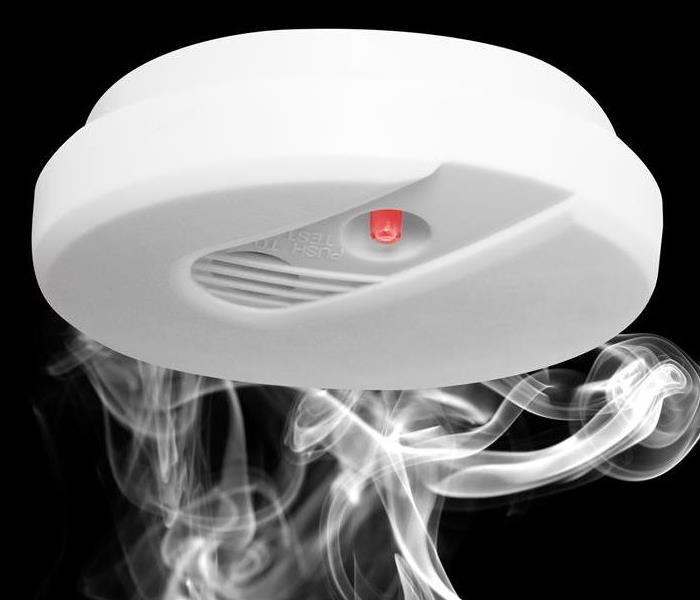 Prevent residential fire in your Clearfield, UT home by following these important tips.
Prevent residential fire in your Clearfield, UT home by following these important tips.
A house fire is among the top fears of existing homeowners. The thoughts of devastation, damage, injury, and loss are enough to set shivers down the spine of even the most prepared owner, even those who have a fire alarm in every recommended space.
These important tips will help you to prevent Residential Fire
Smoke and fire detectors are essential protective devices for the home. Unfortunately, many people either do not see the significance of the products or have fewer alarms than they should.
Talk to a restoration service in Clearfield, UT, to learn more about the number of detectors needed for your home and about proper placement. The general areas of concern include:
- Bedrooms
- Kitchens
- Laundry rooms
- Basements
- Attics
The Fire Alarm: Quantity and Placement
Fires move at various speeds, dependent on what is feeding the fire. Fire and smoke detectors can provide homeowners with valuable insight into the movements of the fire, allowing for a quicker and safer escape. Additionally, the sooner a family receives an alert, the sooner they can call for help or use fire extinguishers to eliminate the threat, resulting in less structural and smoke damage.
However, without the adequate number and placement of alarms, your house and family are at risk of damage and injury.
Understanding how the size of your home and the number of rooms affects your decisions will help ensure your family stays safe in an emergency.
How Many Fire Alarms Do You Need?
While the primary reason for alarms is not to prevent fire damage, it can be a natural side effect of having an adequate number of devices in your home. Because families are alerted to danger quickly, fire response is sped up as well, resulting in less damage. However, for a rapid response, you need to ensure enough fire alarms in your home. How many will depend on the size of your home and the number of bedrooms and levels.
You typically want one alarm in each bedroom and one on every floor. You might also want an alarm in high-risk areas like kitchens and laundry rooms. The bare minimum recommendation is one detector per 500 square feet, with no more than 30 feet between each.
Where Should You Install Fire Alarms?
Fire alarms need to be in high traffic and low traffic areas of the home. For instance, while you might not use your basement or attic that often, fires can start in each location, leading to significant damage.
Additionally, you need the alarms to be where you can hear them. Interconnected alarms are often suggested because they alert a family to a fire's location wherever they are in the home. The best placement for alarms is anywhere fire is possible, and anywhere someone can hear it. Therefore, bedrooms, kitchens, laundry areas, basements, garages, attics, etc.
A fire alarm is a necessary safety device, and every family should have the appropriate number of alarms for their house. If you are not sure how many alarms are needed for your home or the best placement for those alarms, contact your local fire department of a fire mitigation service for help.
Items To Throw Away After a Fire
10/18/2021 (Permalink)
 Some items, after a fire in your Clearfield, UT home, should be thrown away.
Some items, after a fire in your Clearfield, UT home, should be thrown away.
When your home in Clearfield, UT, catches fire, you may have to replace a lot of things. Important documents may be destroyed, and it may be less expensive to replace certain textiles rather than pay to have them cleaned. Fire restoration experts can help you determine which items are salvageable. There are some items, however, that you must always throw away after they are exposed to a house fire.
Items To Throw Away
Food Damaged by High Heat
It makes sense that perishable food that clearly smells like smoke or is packaged in a porous container such as cardboard would need to be thrown away after a fire. Even items that look ok on the surface may need to be tossed in the trash, too, though. If your pantry and refrigerator were exposed to high heat, you need to throw out everything in them:
- Canned foods
- Dry goods
- Spices
- Oils
- Condiments
While it is certainly disheartening to have to get rid of so much food, it is better to waste it by throwing it in the trash than to eat it and make yourself sick. Food that is exposed to the conditions of a house fire often starts to grow bacteria and spoil, even if its packaging still looks intact. To be on the safe side, toss it out and rebuild your pantry stash.
Medicine Exposed to Flames
The chemical composition of medication is uniquely formulated to produce specific health benefits. A fire changes all of that. If your medication was close enough to the fire for the packaging to melt, you definitely need to get rid of it. It is no longer safe to take.
In fact, unless the fire in your home was in a very small, contained area, you can't guarantee that the room where your medication is stored remained cool enough to keep it safe. It's best to throw away all pills and other drugs in the house, even if they don't show signs of burning or smoke damage.
Cosmetics Stored Near Affected Area
The same rules apply to your cosmetics and toiletries. Regardless of what the expiration date on the container says, if they were exposed to the heat of the fire in any way, you should consider them collateral fire damage and toss them out.
If the fire was near the bathroom or vanity where your cosmetics are stored, they have probably been ruined. Take pictures and make a list of all the items as you pitch them into the trash so that you know what you need to replace. This may be helpful information when you are filing your insurance claim. Depending on your policy, you may be compensated for the cost to replace them.
A house fire can be devastating in many ways. Some of your belongings may be able to be saved, but that doesn't apply to everything. Perishable items such as food, medicine, and cosmetics are sensitive to the heat produced in a house fire. You must throw away anything that could have been chemically altered by the presence of fire and replace it with something new.
Home Fire Safety Tips
8/19/2021 (Permalink)
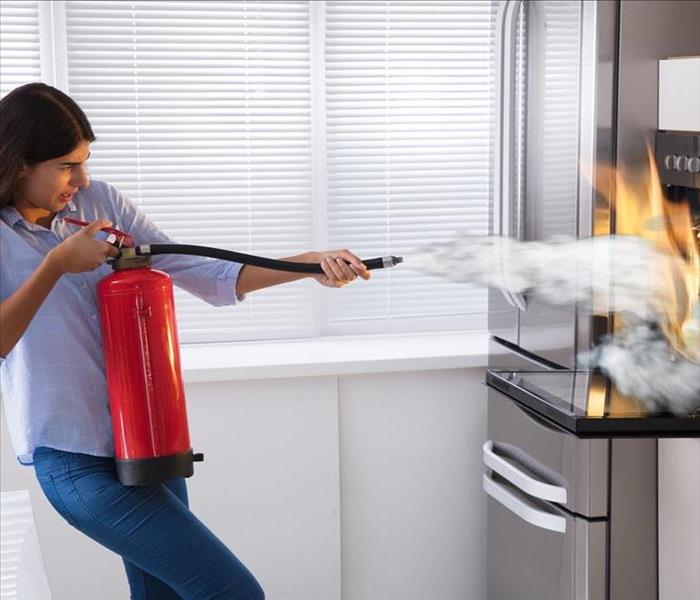 If you can't control the fire with a fire extinguisher in your home in Clearfield, UT, call professionals to avoid further damages.
If you can't control the fire with a fire extinguisher in your home in Clearfield, UT, call professionals to avoid further damages.
Every homeowner likes to believe that his or her house is safe from fires. A fire in your home in Clearfield, UT, can break out much more easily and quickly than you think, though. The smallest error, such as leaving a candle burning too long or forgetting a burner on the stove is on, can ignite a larger flame in no time. When this happens, you should have the security of knowing that every family member knows the proper procedure for handling it. This starts by teaching everyone how to use a fire extinguisher.
The PASS Method
The moment an emergency happens is an unfortunate time to discover that you don't know how to address it. It doesn't do you any good to have a fire extinguisher near your kitchen if you don't know how to use it. Fortunately, all it takes is following an easy four-step process:
Pull - Take the pinout of the top of the extinguisher to unlock it and ready it for use.
Aim - Point the nozzle at the base of the fire.
Squeeze - Apply pressure on the handle to release the agent inside the extinguisher.
Sweep - Slowly but steadily move the stream from the nozzle back and forth along the base of the fire.
If done correctly, the PASS method should put out most small fires that occur in your home. If the flames still persist after you have emptied the canister of the fire extinguisher, don't reach for another one to try again. It's time to let the professionals take over. Call 911 and evacuate the house.
The Right Extinguisher
Not all fires are the same, so it makes sense that different extinguishers would need to hold different types of agents. When you are choosing the right fire safety equipment for your home, look at the ratings. An "A" rating means it is most useful for trash, paper, and wood fires. A "B" rating means that it contains an agent that works best on flammable liquids. A "C" rating is what you need for areas where electrical fires are possible. According to fire damage mitigation experts, the best extinguisher to fight a kitchen fire will have at least a "B-C" rating, if not all three.
The Best Prevention
One of the goals of fire safety is to prevent as much fire damage to your home as possible. Of course, the best prevention is to avoid circumstances that cause the fire in the first place. Since the kitchen is one of the most common places where home fires occur, it's imperative that everyone who uses the kitchen understands basic safety measures. For example, remember to turn the oven and stove off when you're not using them. Don't keep items on top of the stove that are likely to ignite. Clean up oil and grease messes as soon as they occur.
Having a fire extinguisher handy in every area of your home is an essential part of any solid fire safety plan. If you can't prevent a fire altogether, knowing how to handle it quickly and efficiently is the next best option.
4 Tips for Taking Care of Your Home’s Smoke Alarms
5/25/2021 (Permalink)
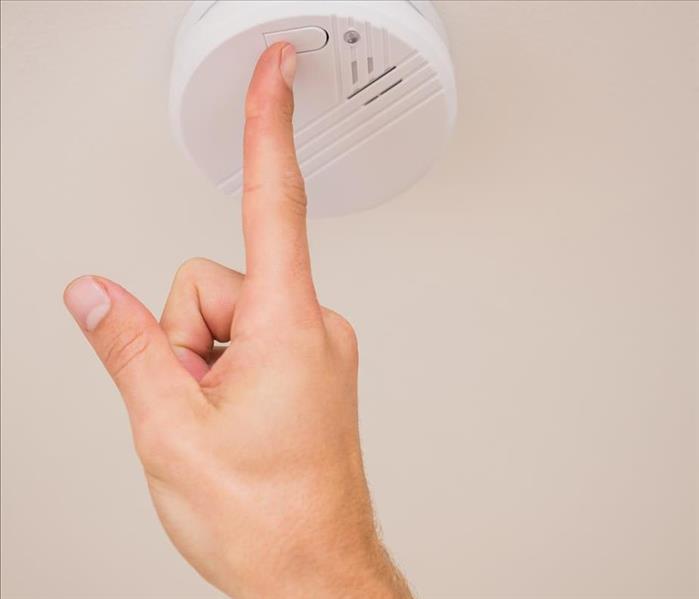 Take care of your home's smoke detector.
Take care of your home's smoke detector.
Often, daily life gets in the way of remembering everything that comes with managing a home. These routine tasks must include smoke alarm care. Keeping your units functioning properly could one day mean the difference between incurring only minimal fire damage and losing everything. Therefore, it's vital to inspect and maintain them regularly. Consider these tips for taking care of a smoke detector.
Tips for Taking Care of a Smoke Detector
1. Maintaining the System
Dust or vacuum your alarms regularly to free the unit of dust and other contaminants. These particles can interfere with the alarm's detection ability.
2. Testing the Units
Manufacturers of all types of smoke alarms recommend testing them at least once each month to ensure they're functioning correctly. You can try them by pressing the test button on each unit. You can go a step further and test them by introducing a small amount of smoke near them.
3. Replacing the Batteries
A smoke detector that runs on a nine-volt battery should have the battery replaced at least once a year. A smoke alarm that utilizes a "long-life" lithium battery doesn't have the capability of replacing the battery. Therefore, the unit itself must be replaced (consult the manufacturer's instructions). An alarm that's hardwired into the home's electrical system has a battery backup. You should replace the backup battery at least once a year.
4. Replacing the Units
Whatever type of smoke detectors you have in your home in Clearfield, UT, fire damage experts recommend replacing the units themselves every 10 years from the manufacture date. You can find this date on the back of the device.
When you're checking off the list of routine home tasks, don't forget smoke alarm maintenance. Taking these proactive steps could prove to be one of the most important jobs you perform if the worst happens. Take care of your alarm system to ensure the welfare of your family and home.




 24/7 Emergency Service
24/7 Emergency Service







